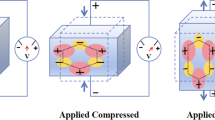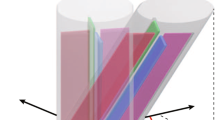Abstract
Piezoelectric bar-shaped resonators were proposed to act as hardness sensors in the 1960s and stiffness sensors in the 1990s based on the contact impedance method. In this work, we point out that both multilayer and unimorph (or bimorph) piezoelectric actuators could act as stiffness/modulus sensors based on the principle of mechanical contact resonance. First, the practical design and the performance of a piezoelectric unimorph actuator–based stiffness sensor were presented. Then the working principle of piezoelectric multilayer actuator–based stiffness sensors was given and verified by numerical investigation. It was found that for these two types of resonance-based sensors, the shift of the resonance frequency due to contact is always positive, which is different from that of the contact impedance method. Further comparative sensitivity study indicated that the unimorph actuator–based stiffness sensor is very suitable for measurement on soft materials, whereas the multilayer actuator–based sensor is more suitable for hard materials.
Graphical Abstract

Both multilayer (or bar-shaped) and unimorph (bimorph) piezoelectric actuators can be used as stiffness/modulus sensors based on the mechanical contact resonance.







Similar content being viewed by others
References
Uchino, K.: Ferroelectric Devices. Marcel Decker, New York (2000)
Jaffe, B.: Piezoelectric Ceramics. Academic Press, London (1971)
Wang, Q.M., Cross, L.E.: Performance analysis of piezoelectric cantilever bending actuators. Ferroelectrics 215, 187–213 (1998)
Benech, P., Chamberod, E., Monllor, C.: Acceleration measurement using PVDF. IEEE Trans. Ultrason. Ferroelectr. Freq. Control 43, 838–843 (1996)
Kleesattel, C., Gladwell, G.: The contact-impedance meter-1. Ultrasonics 6, 175–180 (1968)
Gladwell, G., Kleesattel, C.: The contact-impedance meter-2. Ultrasonics 6, 244–251 (1968)
Kleesattel, C., Gladwell, G.: The contact-impedance meter-3. Ultrasonics 7, 57–62 (1969)
Omata, S., Terunuma, Y.: New tactile sensor like the human hand and its applications. Sensor Actuator A 35, 9–15 (1992)
Aoyagi, R., Yoshida, T.: Frequency equations of an ultrasonic vibrator for the elastic sensor using a contact impedance method. Jpn. J. Appl. Phys. 43, 3204 (2004)
Murayama, Y., Constantinou, C.E., Omata, S.: Micro-mechanical sensing platform for the characterization of the elastic properties of the ovum via uniaxial measurement. J. Biomech. 37, 67–72 (2004)
Uchio, Y., Ochi, M., Adachi, N., et al.: Arthroscopic assessment of human cartilage stiffness of the femoral condyles and the patella with a new tactile sensor. Med. Eng. Phys. 24, 431–435 (2002)
Hurley, D.C.: Contact resonance force microscopy techniques for nanomechanical measurements. In: Bushan, B., Fuchs, H. (eds.) Applied Scanning Probe Methods XI, pp. 97–138. Springer, Berlin (2009)
Zhou, X., Fu, J., Li, F.: Contact resonance force microscopy for nanomechanical characterization: accuracy and sensitivity. J. Appl. Phys. 114, 064301 (2013)
Zhou, X., Fu, J., Li, Y., et al.: Nanomechanical mapping of glass fiber reinforced polymer composites using atomic force acoustic microscopy. J. Appl. Polym. Sci. 131, 39800 (2014)
Pritz, T.: Measurement methods of complex Poisson’s ratio of viscoelastic materials. Appl. Acoust. 60, 279–292 (2000)
O’Brien, D.J., Sottos, N., White, S.R.: Cure-dependent viscoelastic Poisson’s ratio of epoxy. Exp. Mech. 47, 237–249 (2007)
Rao, S.S.: Vibration of Continuous Systems. Wiley, Hoboken (2007)
Turner, J.A., Wiehn, J.S.: Sensitivity of flexural and torsional vibration modes of atomic force microscope cantilevers to surface stiffness variations. Nanotechnology 12, 322–330 (2001)
Fu, J., Lin, L., Zhou, X., et al.: A macroscopic non-destructive testing system based on the cantilever-sample contact resonance. Rev. Sci. Instrum. 83, 123707 (2012)
Acknowledgments
The authors gratefully acknowledge the financial support of the National Natural Science Foundation of China (Grant 11090331). Support from the Chinese National Programs for Scientific Instruments Research and Development (Grant 2012YQ03007502) is also acknowledged.
Author information
Authors and Affiliations
Corresponding author
Rights and permissions
About this article
Cite this article
Fu, J., Li, FX. A comparative study of piezoelectric unimorph and multilayer actuators as stiffness sensors via contact resonance. Acta Mech. Sin. 32, 633–639 (2016). https://doi.org/10.1007/s10409-015-0540-4
Received:
Revised:
Accepted:
Published:
Issue Date:
DOI: https://doi.org/10.1007/s10409-015-0540-4




